12th Economics Chapter 3A (Demand Analysis) Maharashtra Board – Free Solution
Table of Contents
12th Economics Chapter 3A – Demand Analysis
Chapter 3A – Demand Analysis
Q. 1. Complete the following statements by choosing the correct alternative
1) The relationship between demand for a good and price of its substitute is _____.
a) direct
b) inverse
c) no effect
d) can be direct and inverse
2) The relationship between income and demand for inferior goods is _____.
a) direct
b) inverse
c) no effect
d) can be direct and inverse
3) Symbolically, the functional relationship between Demand and Price can be expressed as _____.
a) Dx = f(Px)
b) Dx = f(Pz)
c) Dx = f(y)
d) Dx = f(T)
4) When less units are demanded at high price it shows _____.
a) increase in demand
b) expansion of demand
c) decrease in demand
d) contraction in demand

Q. 2. Give economic terms
1) A situation where more quantity is demanded at lower price. Expansion of Demand.
2) Graphical representation of demand schedule. Demand curve
3) A commodity which can be put to several uses. Multipurpose commodity
4) More quantity is demanded due to changes in the factors determining demand other than price. Increase in Demand
5) A desire which is backed by willingness to purchase and ability to pay. Demand
Solution of other subjects
Solution of all Chapters of Economics
1 – 2 – 3A – 3B – 4 – 5 – 6 – 7 – 8 – 9 – 10
Q.3. Distinguish between
1) Desire and Demand.
| Desire | Demand |
| Desire means an urge to have something. | Demand means a desire which is backed by willingness and ability to pay. |
| Desire has no relation with the price, place and time. | Demand has relation with the price, place and time. |
2) Expansion of demand and Contraction of demand.
| Expansion of Demand. | Contraction of Demand. |
| Expansion of demand refers to rise in quantity demanded due to fall in price alone while other factors like tastes, income of the consumer, size of population etc. remain unchanged. | Contraction of demand refers to a fall in demand due to rise in price alone. Other factors like tastes, income of the consumer, size of population etc. remain unchanged. |
| Demand curve moves in downward direction on the same demand curve. | Demand curve moves in the upward direction on the same demand curve. |
3) Increase in demand and Decrease in demand.
| Increase in Demand. | Decrease in Demand. |
| It refers to an increase in quantity demanded due to favorable changes in other factors like tastes, income of the consumer, climatic conditions etc. and price remains constant. | It refers to a decrease in quantity demanded due to unfavorable changes in other factors like tastes, income of the consumer, climatic conditions etc. and price remains constant. |
| Demand curve shifts to the right hand side of the original demand curve. | Demand curve shifts to left hand side of the original demand curve. |
Q.4. State with reasons whether you agree or disagree with the following statements
1) Demand curve slopes downward from left to right.
Ans. Yes, I agree with the above statement.
Reasons: a) According to Prof. Alfred Marshall, “Other things being equal, higher the price of a
commodity, smaller is the quantity demanded and lower the price of a commodity, larger is the
quantity demanded.”
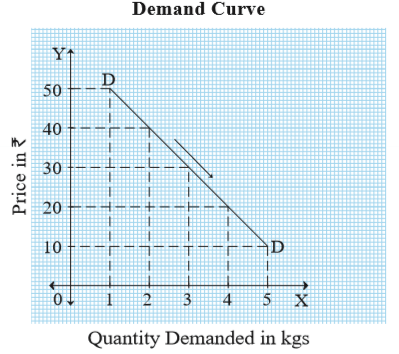
Following are the main reasons why demand curve slopes downward from left to right.
b) Law of Diminishing Marginal Utility: We have seen that marginal utility goes on diminishing with an increase in the stock of a commodity and vice-versa.
c) Income effect: When price falls, purchasing power of a consumer increases which enables him to buy more of that commodity. This is known as income effect.
d) Substitution effect: When the price of a commodity rises, the consumer tends to buy more of its substitute and less of that commodity whose price has increased. This is known as substitution effect.
2) Price is the only determinant of demand.
Answer.No, I disagree with the above statement.
Reasons: There are various factors other than price that determines demand.
a) Income: Income of a consumer decides purchasing power which in turn influences the demand for the product.
b) Prices of Substitute Goods: If a substitute good is available at a lower price then people will demand cheaper substitute good than costly good. For example, if the price of sugar rises then demand for jaggery will rise.
c) Price of Complementary Goods: Change in the price of one commodity would also affect the demand for other commodity. For example, car and fuel. If the price of fuel rises, then demand for cars will fall.
d) Nature of product: If a commodity is a necessity and its use is unavoidable, then its demand will continue to be the same irrespective of the corresponding price. For example, medicine to control blood pressure.
3) When price of Giffen goods fall, the demand for it increases.
Ans.No, I disagree with the above statement.
Reasons: a) Inferior goods or low quality goods are those goods whose demand does not rise even if their price falls.
b) At times, demand decreases when the price of such commodities fall.
c) Sir Robert Giffen observed this behaviour in England in relation to bread. He noted that, when the price of bread declined, people did not buy more because of an increase in their real income or purchasing power. They preferred to buy superior good like meat. This is known as Giffen’s paradox.
Thus, when price of Giffen goods fall, the demand for it does not increases but decreases.
Solution of other subjects
Solution of all Chapters of Economics
1 – 2 – 3A – 3B – 4 – 5 – 6 – 7 – 8 – 9 – 10
Q.5. Observe the given table and answer the questions
1) a) Complete the market demand schedule.
| Price per kg. in Rs | Consumer A | Consumer B | Consumer C | Market demand (in kgs) (A+B+C) |
| 25 | 16 | 15 | 12 | 43 |
| 30 | 12 | 11 | 10 | 33 |
| 35 | 10 | 09 | 08 | 27 |
| 40 | 08 | 06 | 04 | 18 |
b) Draw market demand carve based on above market demand schedule.

2) Observe the given diagram and answer the following questions :
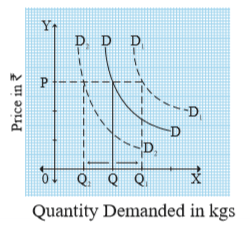
1) Rightward shift in demand curve. Increase in demand
2) Leftward shift in demand curve. Decrease in demand
3) Price remains Constant (OP)
4) Increase and decrease in demand comes under Change in demand
3) Explain the diagrams
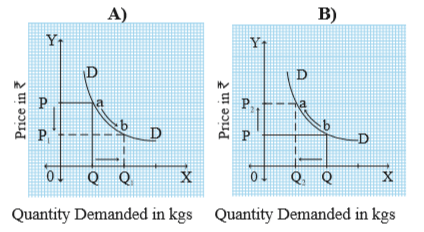
| A | B |
| 1) Diagram A represents Expansion in demand | 2) Diagram B represents Contraction in demand |
| 2) In diagram A movement of demand curve is in downward direction | 2) In diagram A movement of demand curve is in upward direction |
Q.6. Answer in detail:
1) State and explain the law of demand with exceptions.
Solution: Law of Demand :
The law of demand was introduced by Prof. Alfred Marshall in his book, ‘Principles of 00 Economics’, which was published in 1890. The law explains the functional relationship between price and quantity demanded.
Statement of the Law: According to Prof. Alfred Marshall, “Other things being equal, higher the price of a commodity, smaller is the quantity demanded and lower the price of a commodity, larger is the quantity demanded.”
In other words, other factors remaining constant, if the price of a commodity rises, demand for it falls and when price of a commodity falls demand for the commodity rises. Thus, there is an inverse relationship between price and quantity demanded. Symbolically, the functional relationship between demand and price is expressed as :
Dx = f (Px)
Where D = Demand for a commodity
x = Commodity
f = Function
Px = Price of a commodity
The law of demand is explained with the help of the following demand schedule and diagram.
Demand schedule:
| Price of commodity ‘x’ (Rs) | Quantity demanded of commodity ‘x’ (in kgs.) |
| 50 | 1 |
| 40 | 2 |
| 30 | 3 |
| 20 | 4 |
| 10 | 5 |
As shown in the above Table when price of commodity ‘x’ is Rs.50, the quantity demanded is 1 kg. When the price falls from Rs 50 to Rs 40, quantity demanded rises from 1kg to 2 kg. Similarly at a price of Rs 30, quantity demanded is 3 kgs and when price falls from Rs.20 to Rs.10, the quantity demanded rises from 4 kg sto 5 kg
Thus, as the price of a commodity falls, quantity demanded rises and when price of a commodity rises, quantity demanded falls. This shows an inverse relationship between price and quantity demanded.

Explanation of the Diagram :
In the above diagram X axis represents the demand for the commodity and Y axis represents the price of commodity x. DD is the demand curve which slopes downward from left to right due to an inverse relationship between price and quantity demanded.
Exceptions to the Law of Demand:
There are certain exceptions to the law of demand. It means that under exceptional circumstances, consumer buys more when the price of commodity rises and buys less when price of commodity falls. In such cases, demand curve slopes upwards from left to right. i.e. the demand curve has a positive slope as shown in fig

Following are the exceptions to the law of Demand:
1) Giffen’s paradox : Inferior goods or low quality goods are those goods whose demand does not rise even if their price falls. At times, demand decreases when the price of such commodities fall.
Sir Robert Giffen observed this behaviour in England in relation to bread. He noted that, when the price of bread declined, people did not buy more because of an increase in their real income or purchasing power. They preferred to buy superior good like meat. This is known as Giffen’s paradox.
2) Prestige goods: Expensive goods like diamond, gold etc. are status symbol. So rich people buy more of it, even when their prices are high.
3) Speculation: The law of demand does not hold true when people expect prices to rise still further. In this case, although the prices have risen today, consumers will demand more in anticipation of further rise in price. For example, prices of oil, sugar etc. tend to rise before Diwali. So people go on purchasing more at a high price as they anticipate that prices may rise during Diwali.
4) Price illusion: Consumers have an illusion that high priced goods are of better quality. Therefore, the demand for such goods tends to increase with a rise in their prices. For example, branded products which are expensive are demanded even at a high price.
5) Ignorance : Sometimes, due to ignorance people buy more of a commodity at high price. This may happen when consumer is ignorant about the price of that commodity at other places.
6) Habitual goods : Due to habit of consumption, certain goods like tea is purchased in required quantities even at a higher price.
Solution of other subjects
Solution of all Chapters of Economics
1 – 2 – 3A – 3B – 4 – 5 – 6 – 7 – 8 – 9 – 10
2) Explain in detail the determinants of demand.
Solution:
Determinants of Demand
The demand for goods is determined by the following factors.
1) Price: Price determines the demand for a commodity to a large extent. Consumers prefer to purchase a product in large quantities when price of a product is less and they purchase a product in small quantities when price of a product is high.
2) Income: Income of a consumer decides purchasing power which in turn influences the demand for the product. Rise in income will lead to a rise in demand for the commodity and a fall in income will lead to
a fall in demand for the commodity.
3) Prices of Substitute Goods: If a substitute good is available at a lower price then people will demand cheaper substitute good than costly good. For example, if the price of sugar rises then demand for jaggery will
rise.
4) Price of Complementary Goods: Change in the price of one commodity would also affect the demand for other commodity. For example, car and fuel. If the price of fuel rises, then demand for cars will fall.
5) Nature of product: If a commodity is a necessity and its use is unavoidable, then its demand will continue to be the same irrespective of the corresponding price. For example, medicine to control blood pressure.
6) Size of population: Larger the size of population, greater will be the demand for a commodity and smaller the size of population smaller will be the demand for a commodity.
7) Expectations about future prices: If the consumer expects the price to fall in future, he will buy less in the present at the prevailing price. Similarly, if he expects the price to rise in future, he will buy more in the present at the prevailing price.
8) Advertisement: Advertisement, sales promotion scheme and effective salesmanship tend to change the preferences of the consumers and lead to demand for many products. For example, cosmetics, toothbrush etc.
9) Tastes, Habits and Fashions: Taste and habits of a consumer influence the demand for a commodity. If a consumer likes to eat chocolates or consume tea, he will demand more of them. Similarly, when a new fashion hits the market, the consumer demands that particular type of commodity. If a commodity goes out of fashion then suddenly the demand for that product tends to fall.
10) Level of Taxation: High rates of taxes on goods or services would increase the price of the goods or services. This, in turn would result in a decrease in demand for goods or services and vice-versa.
Extra Questions
Distinguish Between:
1) Individual Demand and Market Demand
| Individual Demand | Market Demand |
| Individual demand is the quantity of a commodity demanded by a consumer at a given price during a given period of time. | Market demand is the total demand for a commodity from all the consumers at a given price during a given period of time. |
| Individual demand is always less than market demand. | Market demand is always greater than Individual demand. |
2) Direct Demand and Indirect Demand
| Direct Demand | Indirect Demand |
| It is the demand by the consumer for goods that satisfy their wants directly. | It refers to demand for goods that are needed for further production. |
| it is the demand for consumer goods. For example, demand for cloth, sugar, etc. | all factors of production have indirect or derived demand. For example, demand for workers in a sugar factory is derived or indirect demand. |
Answer the following questions.
I) State and explain the law of Demand and Explain its assumption.
Answer:
Refer to QNO 6 (1) for the Law of Demand.
The following are the assumptions of the law of demand:
1) Constant level of income:
If the law of demand is to find true operate then consumers’ income should remain constant. If there is a rise in income, people may demand more at a given price.
2) No change in size of population:
It is assumed that the size of the population remains unchanged. Any change in the size and composition of a country’s population affects the total demand for the product.
3) Prices of substitute goods remain constant:
It is assumed that the prices of substitutes remain unchanged. Any change in the price of the substitute will affect the demand for the commodity.
4) Prices of complementary goods remain constant:
It is assumed that the prices of complementary goods remain unchanged because a change in the price of one goods will affect the demand for the other.
5) No expectations about future changes in prices:
It is assumed that consumers do not expect any further change in price in the near future. If consumers expect a rise in prices in future, they may demand more in the present even at existing high price.
6) No change in tastes, habits, preferences, fashions, etc.:
It is assumed that consumers’ tastes, habits, preferences, fashions, etc. should remain unchanged. Any change in these factors will lead to a change in demand.
7) No change in taxation policy:
Taxation policy of the government has a great impact on demand for various goods and services. Therefore, it is assumed that there is no change in the policy of taxation declared
by Government.
II) Explain the Individual and Market demand. (Explain the Concept of Demand with Schedule)
Answer: Definition of Demand:
According to Benham, “the demand for anything at a given price is the amount of it, which will be bought per unit of time at that price.”
Thus, the following are the features of demand :
1) Demand is a relative concept.
2) Demand is essentially expressed with reference to time and price.
Demand Schedule:
A demand schedule is a tabular representation of the functional relationship between price and quantity demanded for a particular commodity.
A demand schedule may be either an individual demand schedule or a market demand schedule.
Individual Demand Schedule:
Individual demand is the quantity of a commodity demanded by a consumer at a given price during a given period of time.
This can be explained with the help of the following individual demand schedule.
| Price of commodity ‘x’ ( Rs ) | Quantity demanded of commodity ‘x’ (in kgs) |
| 10 | 1 |
| 8 | 2 |
| 6 | 3 |
| 4 | 4 |
| 2 | 5 |
The above table shows different quantities of commodity ‘x’ purchased by an individual consumer at various prices. It can be observed that less quantity of commodity is demanded at rising prices and more quantity of commodity is demanded at falling prices. It indicates an inverse relationship between price and quantity demanded.
Individual Demand Curve :
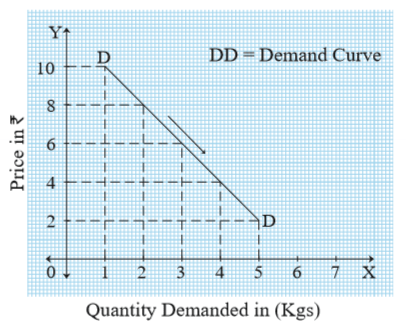
Market Demand Schedule:
Market demand is the total demand for a commodity from all the consumers at a given price during a given period of time.
This can be explained with the help of following market demand schedule.
| Price of commodity ‘x’ ( Rs ) | Quantity demanded of commodity ‘x’ (in kgs) Consumer A | Quantity demanded of commodity ‘x’ (in kgs) Consumer B | Quantity demanded of commodity ‘x’ (in kgs) Consumer C | Market demand A+B+C |
| 10 | 5 | 10 | 15 | 30 |
| 8 | 10 | 15 | 20 | 45 |
| 6 | 15 | 20 | 25 | 60 |
| 4 | 20 | 25 | 30 | 75 |
| 2 | 25 | 30 | 35 | 90 |
shows different quantities of commodity x purchased by different consumers (A, B, C) at various prices. It can be observed that less quantity of commodity is demanded at rising prices and more quantity of commodity
is demanded at falling prices. Thus, there is an inverse relationship between price and quantity
demanded.
Market Demand Curve:
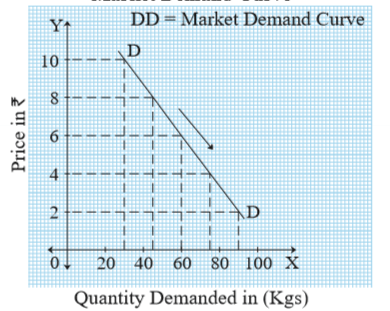
III) Explain the various types of Demand.
Answer:
Types of Demand
1) Direct demand:
It is the demand by the consumer for goods that satisfy their wants directly. They serve the direct consumption needs of the consumers. Thus, it is the demand for consumer goods. For example, demand for cloth, sugar, etc.
2) Indirect demand:
Indirect demand is also known as derived demand. It refers to the demand for goods that are needed for further production. It is the demand for producer’s goods. Hence, all factors of production have indirect or derived demand. For example, demand for workers in a sugar factory is derived or indirect demand.
3) Complementary/Joint demand:
When two or more goods are demanded jointly to satisfy a single want, it is known as joint or complementary demand. For example, car and fuel, etc.
4) Composite demand:
The demand for a commodity that can be put to several uses is known as composite demand. For example, electricity is demanded for several uses such as light, fan, washing machine, etc.
5) Competitive demand:
It is demand for those goods which are substitutes for each other. For example, tea or coffee, sugar or jaggery, etc.
IV) Explain variation in Demand.
\Answer:
When the demand for a commodity falls or rises due to a change in price alone and other factors remain constant, it is called variation in demand. It is of two types :
1) Expansion of demand:
Expansion of demand refers to rise in quantity demanded due to a fall in price alone while other factors like tastes, income of the consumer, size of population, etc. remain unchanged. Demand moves in a downward direction on the same demand curve.
This is explained with the help of the following figure.
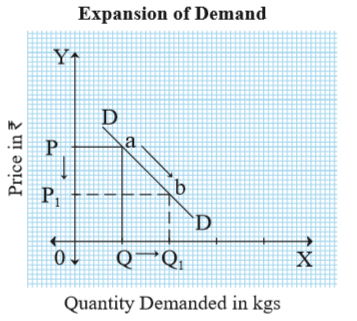
As shown in above fig. DD is the demand curve. A downward movement on the same demand curve from point a to point b indicates an expansion of demand.
2) Contraction of Demand:
Contraction of demand refers to a fall in demand due to rise in price alone. Other factors like tastes, income of the consumer, size of population, etc. remain unchanged. The demand curve moves in the upward direction on the same demand curve.
This can be explained with the help of the following Fig.
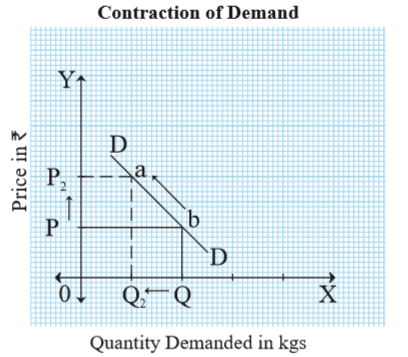
As shown in above fig. DD is a demand curve. An upward movement on the same demand curve from point b to point a shows contraction of demand.
V) Explain change in demand.
Answer:
Changes in Demand: When demand for a commodity increases or decreases due to changes in other factors and price remains constant, it is known as a change in demand. It is of two types :
1) Increase in demand:
It refers to an increase in quantity demanded due to favorable changes in other factors like tastes, income of the consumer, climatic conditions, etc. and price remains constant. The demand curve shifts to the right-hand side of the original demand curve.
This can be explained with the help of fig.
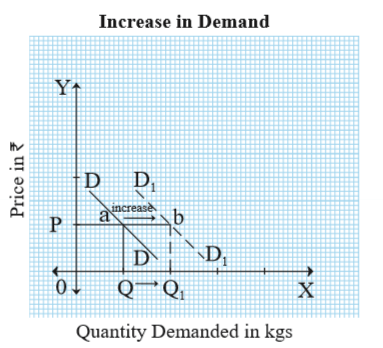
2) Decrease in demand:
It refers to a decrease in quantity demanded due to unfavorable changes in other factors like tastes, income of the consumer, climatic conditions etc. and price remains constant. The demand curve shifts to left hand side of the original demand curve.
This can be explained with the help of fig.
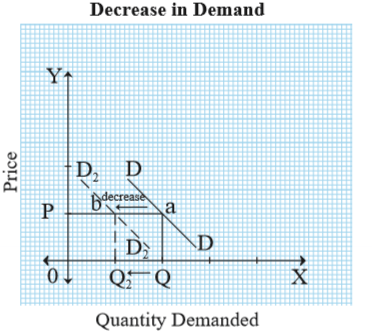
As shown in Fig., DD is the original demand curve. It shifts inward to the left from DD to D2D2 which indicates a decrease in demand.
Check out other posts related to the 12th Commerce
Online lectures of Class 12 Commerce
🔗 Share our videos and channel with your friends, and help us grow this channel.
Learn the Chapters of Accounts from our playlist.



1 Response
[…] Click Here […]